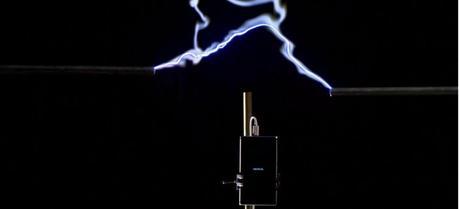 Harnessing the power of lightning to charge your mobile phone is much more impressive (and innovative!) than using wireless charging accessories for Lumia. The question is open, however, as to whether it is safer and more convenient.
Harnessing the power of lightning to charge your mobile phone is much more impressive (and innovative!) than using wireless charging accessories for Lumia. The question is open, however, as to whether it is safer and more convenient.And no, we are not talking about the lightning power connector by Apple. Scientists from the University of Southampton have collaborated with Nokia on proof-of-concept research into harnessing the actual power of lightning for personal use.
With the help of scientist Neil Palmer of the University’s Tony Davies High Voltage Laboratory—one of the world’s leading high voltage laboratories—research was undertaken to investigate how natural power resources could be used to a charge a Nokia Lumia 925 with an energy simulation similar to that of a bolt of lightning.
Since the late 1980s, there have been several attempts to investigate the possibility of harvesting the power of lightning. While a single bolt of lightning carries a relatively large amount of energy (approximately 5 billion joules or about the energy stored in 145 liters of petrol), this energy is concentrated in a small location and is passed during an extremely short period of time (milliseconds); therefore, extremely high electrical power is involved.It has been proposed that the power of lightning be used to generate hydrogen from water, or to harness the energy from rapid heating of water due to lightning, or to use inductors spaced far enough away so that a safe fraction of the energy might be captured.
“We were excited by this challenge presented to us by Nokia. Using an alternating current driven by a transformer, over 200,000 volts was sent across a 300mm gap— giving heat and light similar to that of a lightning bolt. The signal was then stepped into a second controlling transformer, allowing us to charge the phone,” Neil said.
“We were amazed to see that the Nokia circuitry somehow stabilized the noisy signal, allowing the battery to be charged. This discovery proves devices can be charged with a current that passes through the air, and is a huge step towards understanding a natural power like lightning and harnessing its energy,” he added.
“This is a first for any mobile phone company to trial this kind of technology. We obviously aren’t recommending people try this experiment at home, but we are always looking to disrupt and push the boundaries of technology and find innovative ways to improve the performance of our products,” said Chris Weber, Executive Vice President for Sales & Marketing at Nokia.
“As one of the first companies to introduce wireless charging into our products, we believe that this experiment has the potential to jump-start new ideas on how we charge our phones in the future.”
Read about the experiment in Nokia’s blog here.

